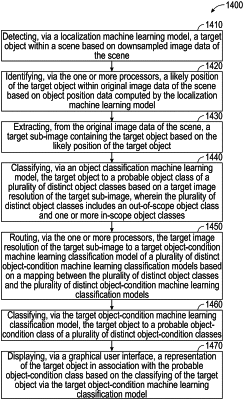| CPC G06V 10/764 (2022.01) [G06V 10/94 (2022.01)] | 30 Claims |

|
1. A computer-program product embodied in a non-transitory machine-readable storage medium storing computer instructions that, when executed by one or more processors, perform operations comprising:
detecting, via a localization machine learning model, a target object within target image data of a scene;
classifying, via an object classification machine learning model, the target object to a probable object class of a plurality of distinct object classes based on an input of the target image data of the scene, wherein the plurality of distinct object classes includes an out-of-scope object class and one or more in-scope object classes;
routing, via the one or more processors, the target image data of the scene to a target object-condition machine learning classification model of a plurality of distinct object-condition machine learning classification models based on a mapping between the plurality of distinct object classes and the plurality of distinct object-condition machine learning classification models;
classifying, via the target object-condition machine learning classification model, the target object to a probable object-condition class of a plurality of distinct object-condition classes; and
displaying, via a graphical user interface, a representation of the target object in association with the probable object-condition class based on the classifying of the target object via the target object-condition machine learning classification model.
|